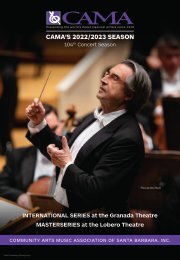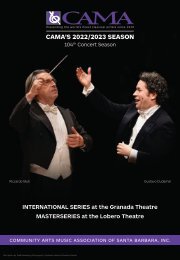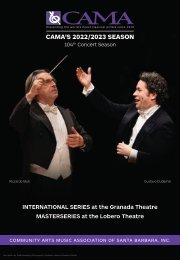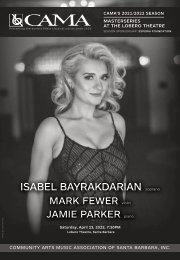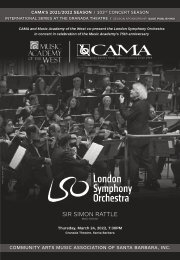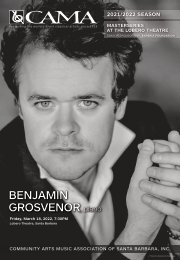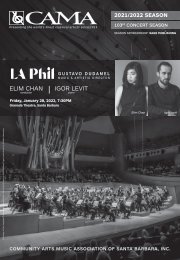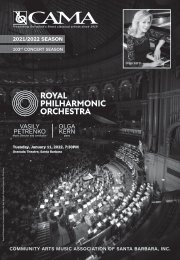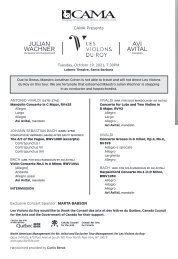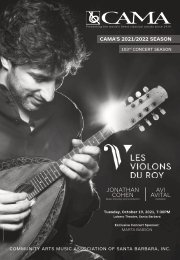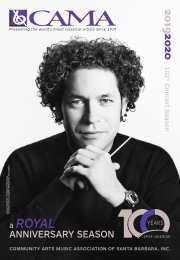May 6, 2019, Monday, 8:00 PM—Mischa Maisky, cello and Lily Maisky, piano—CAMA's Masterseries at The Lobero Theatre
MONDAY, MAY 6, 2019, 8:00 PM Mischa Maisky, cello Lily Maisky, piano Lauded by The Guardian for his “dazzling precision, fleet brilliance, and tender lyricism”, Latvian-born Israeli cello master Mischa Maisky is considered by many worldwide to be one of the handful of greatest living cellists. He has the distinction of being the only cellist in the world to have studied with both Mstislav Rostropovich and Gregor Piatigorsky and to carry on the deep musical legacy of these two great 20th Century Russian masters of the cello. His romantic emotion and absolute musical commitment carry the command of a true artist. It is fitting that Mischa Maisky will return by popular demand to the historic Lobero for the closing recital of CAMA’s historic 100th Concert Season. PROGRAM: Alessandro Marcello (arranged by J.S. Bach; and arranged for cello by Mischa Maisky): Movement II: Adagio, from Concerto in D minor, BWV 974 Johann Sebastian Bach (arr. S. Franco): Movement II: Largo, from Concerto for Harpsichord, Strings and Continuo No.5 in F minor, BWV 1056 Wolfgang Amadeus Mozart (arr. M. Maisky): Pamina’s Aria from The Magic Flute, K.620/Act II: “Ach ich fühl’s, es ist verschwunden” Johannes Brahms: Sonata No.2 in F major, Op.99 Pyotr Ilyich Tchaikovsky (arr. J. Stutschewsky and I. Thaler): No.10: October: “Autumn Song,” from The Seasons, Op.37a, TH 135 P.I. Tchaikovsky (arr. Viktor Kubatsky): No.6, “Valse Sentimentale,” from 6 Pieces, Op.51, TH 143 Dmitri Dmitriyevich Shostakovich: Sonata for Cello and Piano, Op.40
MONDAY, MAY 6, 2019, 8:00 PM
Mischa Maisky, cello
Lily Maisky, piano
Lauded by The Guardian for his “dazzling precision, fleet brilliance, and tender lyricism”, Latvian-born Israeli cello master Mischa Maisky is considered by many worldwide to be one of the handful of greatest living cellists. He has the distinction of being the only cellist in the world to have studied with both Mstislav Rostropovich and Gregor Piatigorsky and to carry on the deep musical legacy of these two great 20th Century Russian masters of the cello. His romantic emotion and absolute musical commitment carry the command of a true artist. It is fitting that Mischa Maisky will return by popular demand to the historic Lobero for the closing recital of CAMA’s historic 100th Concert Season.
PROGRAM:
Alessandro Marcello (arranged by J.S. Bach; and arranged for cello by Mischa Maisky): Movement II: Adagio, from Concerto in D minor, BWV 974
Johann Sebastian Bach (arr. S. Franco): Movement II: Largo, from Concerto for Harpsichord, Strings and Continuo No.5 in F minor, BWV 1056
Wolfgang Amadeus Mozart (arr. M. Maisky): Pamina’s Aria from The Magic Flute, K.620/Act II: “Ach ich fühl’s, es ist verschwunden”
Johannes Brahms: Sonata No.2 in F major, Op.99
Pyotr Ilyich Tchaikovsky (arr. J. Stutschewsky and I. Thaler): No.10: October: “Autumn Song,” from The Seasons, Op.37a, TH 135
P.I. Tchaikovsky (arr. Viktor Kubatsky): No.6, “Valse Sentimentale,” from 6 Pieces, Op.51, TH 143
Dmitri Dmitriyevich Shostakovich: Sonata for Cello and Piano, Op.40
- No tags were found...
Create successful ePaper yourself
Turn your PDF publications into a flip-book with our unique Google optimized e-Paper software.
constitute much of the movement, with the<br />
opening theme or deriv<strong>at</strong>ive motifs nearly<br />
always present in the melodic texture. <strong>The</strong><br />
tremolo is taken over by the <strong>cello</strong>, played<br />
by altern<strong>at</strong>ing the two lowest strings—a<br />
strikingly sonorous effect—through much<br />
of the development <strong>and</strong> coda.<br />
<strong>The</strong> reflective second movement begins<br />
in the distant <strong>and</strong> unrel<strong>at</strong>ed key of F-<br />
sharp major, then enters a sort of tonal noman’s<br />
l<strong>and</strong> in a middle section th<strong>at</strong> drifts<br />
in <strong>and</strong> out of D-fl<strong>at</strong> major on its way to a<br />
modul<strong>at</strong>ion to F minor th<strong>at</strong> never really arrives.<br />
<strong>The</strong> key of F minor does arrive in the<br />
scherzo, the principal theme of which bears<br />
a striking resemblance to the finale of the<br />
Third Symphony (also in F minor), recast<br />
into triple meter, but with the same driving<br />
mood. <strong>The</strong> middle section lies somewhere<br />
between hymn <strong>and</strong> love song. <strong>The</strong> finale,<br />
a carefree rondo in which nothing terribly<br />
important happens, is less a climax than a<br />
dessert after a particularly nutritious meal.<br />
Both Tchaikovsky pieces on the program<br />
were originally composed for solo piano<br />
<strong>at</strong> the behest of Nikolai Bernard, editor<br />
of the St. Petersburg monthly music magazine<br />
Nuvelliste. In a time when a large proportion<br />
of people with disposable income<br />
were skilled am<strong>at</strong>eur instrumentalists, it<br />
made financial sense to publish magazines<br />
containing music for them to play. In a December<br />
1875 letter Bernard asked Tchaikovsky<br />
to compose a piece for each month<br />
of the year, <strong>and</strong> suggested subtitles for<br />
TCHAIKOVSKY<br />
each piece. Tchaikovsky, a better composer<br />
than negoti<strong>at</strong>or, wrote back th<strong>at</strong> he was<br />
“most gr<strong>at</strong>eful for your courtesy <strong>and</strong> readiness<br />
to pay me such a high fee,” <strong>and</strong> supplied<br />
the pieces well ahead of the public<strong>at</strong>ion<br />
schedule. Bernard also supplied each<br />
piece with a poetic epigraph, most of them<br />
by Russian poets unfamiliar to Western<br />
readers. Those verses appear in only two<br />
of Tchaikovsky’s manuscript scores (January<br />
<strong>and</strong> March), so it is not certain th<strong>at</strong> he<br />
had the other ten in mind as he composed.<br />
<strong>The</strong> verse for October, “Autumn Song,” describes<br />
fallen yellowed leaves blowing in<br />
the wind.<br />
In 1882, Bernard again proposed<br />
a set of character pieces, but this time<br />
13 CENTENNIAL SEASON CELEBRATION




